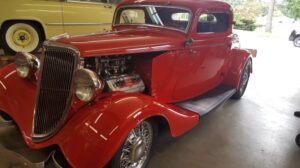Winterize Your Classic Car
December 17, 2021

Jim & JoAnne Hendry’s 1934 Ford
Steps to Winterize
Winter is coming. The first official day of winter this year is December 21st. How much or little you do to winterize your collector vehicle really depends on the length of time it will be stored and how thorough you want to be. These simple precautions can help ensure your prized classic safely slumbers through the winter months.
Get it clean. Wash, wax and polish it up. The wax will help prevent corrosion and tarnish. It also keeps grit and grime from scratching your car when you put on its cover.
Fuel. Fill your classic car’s tank with premium fuel and add a fuel stabilizer. Most fuel contains 10% ethanol which absorbs moisture from the air. So if you live in a humid climate like the Pacific Northwest it is important to store the car with a full tank because this minimizes the possibility of water being absorbed from the air in the unfilled portion of the tank. Adding a fuel stabilizer like Sta-Bil will prevent evaporation that can lead to corrosion in the gas tank. Without a stabilizer, fuel can oxidize and deteriorate and gum up your carburetor, making it difficult to start the engine come spring. After you add the stabilizer, run the engine for a few minutes to distribute it throughout the system. If you know in advance that the vehicle is going into much longer-term storage then you’d be smart to drain the tanks and suck the carburetor’s float bowls dry
Battery. Cold temperatures and a parasitic drain can kill a battery before spring. Disconnect the battery terminals or remove the battery entirely to keep it from discharging in storage. If you have access to electricity then use a battery tender to keep the battery charged. Note you want a maintainer, not a trickle charger. A trickle charger should be disconnected when the battery is fully charged- and can overcharge the battery if it’s not removed. Whereas a maintainer is designed to stay connected to the battery. If you remove the battery entirely, follow these steps to store it properly.

Allan and Sharon Bretz’s 1956 Ford F100
Mouse Repellent. The immense amount of damage rodents can very quickly do is astonishing. Reportedly, rodents don’t like certain smells such as predators (cats, raccoons, & ferrets), citronella, peppermint oil, and eucalyptus. Some people even swear by Bounce dryer sheets and Irish Spring soap. Others by ultrasonic devices. The bottom line is any mouse or rat deterrent is better than nothing.
Tires. If you are storing your classic car for less than four months, you can prevent flat spots on your tires by slightly overinflating them before hibernation. Longer sits in cold weather can cause permanent flat spots in the tires. If you are storing it for longer periods, your best bet is to lift the car on jack stands so all four wheels are up. Short of that, drive the car on occasion or at least move it in the storage space.
Keep it dry. While your classic car is in hibernation, moisture and humidity can lead to mold on its upholstery and carpet. Placing several boxes of baking soda or a product like DampRid Moisture Absorber throughout the interior can help absorb excess moisture.
Cover. Cover your vintage vehicle with a breathable classic car cover (not plastic). This will prevent moisture buildup beneath the cover. Special environmentally controlled storage facilities for classic cars are available if you want to be extra careful. If you keep yours at home, just make sure the storage area is dry, and be prepared to take action at first signs of rodents.
The very best thing you can do is keep the layup short, and if at all possible, drive the car in the middle of the layup.